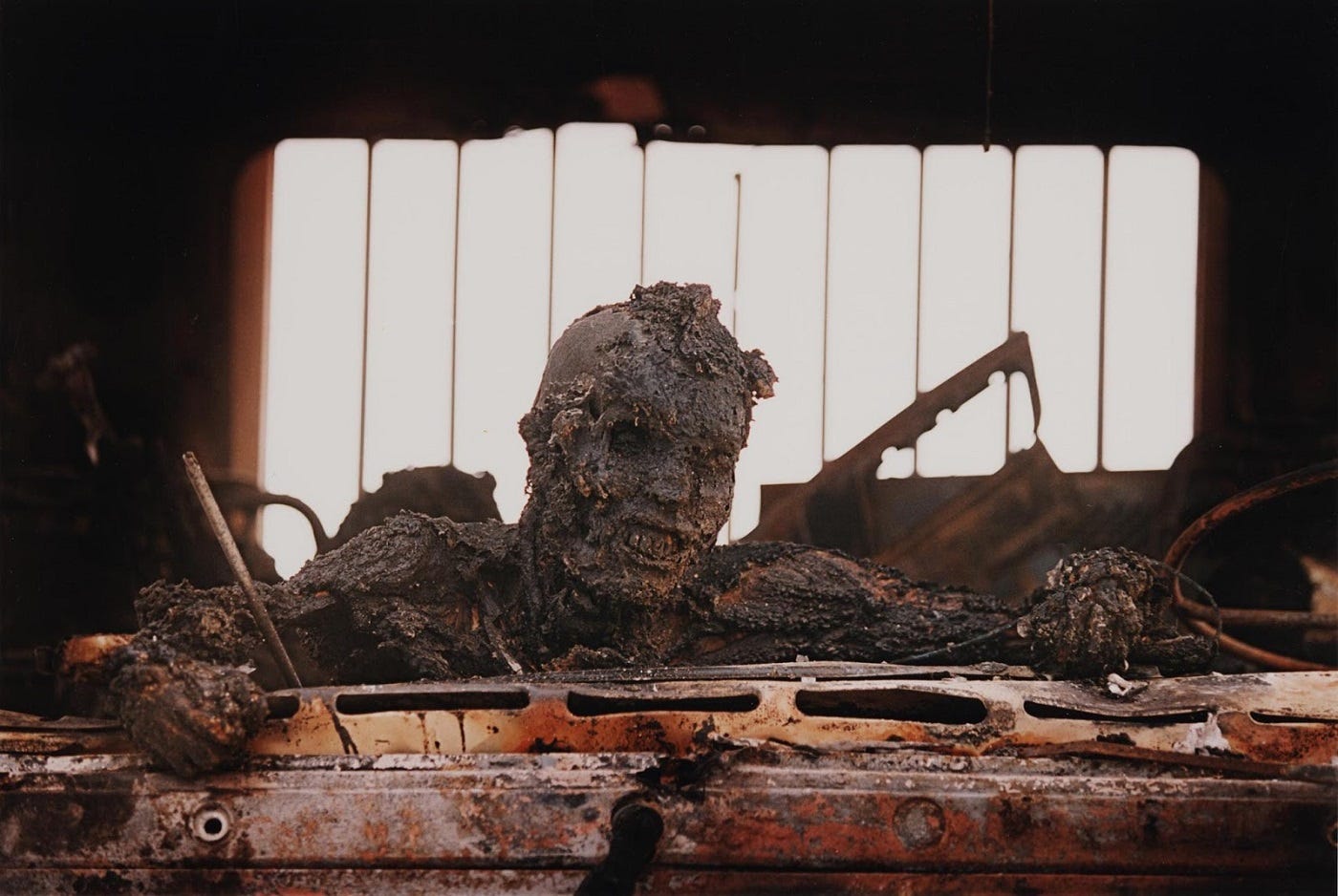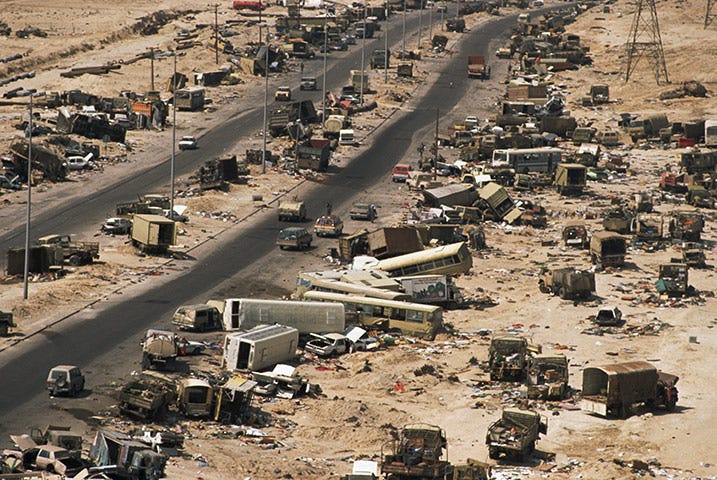“Persons taking no active part in hostilities, including members of armed forces who have laid down their arms and those placed hors de combat by sickness, wounds, detention, or any other cause, shall in all circumstances be treated humanely, without any adverse distinction founded on race, color, religion or faith, sex, birth or wealth, or any other similar criteria.” (Common Article 3 to the four 1949 Geneva Conventions of 1949)
High above a swamp, over 60 miles of coastal Highway 8 from Kuwait to Iraq, a division of Iraq’s Republican Guard withdrew on February 26-27, 1991.
Baghdad radio had just announced Iraq's acceptance of a cease-fire proposal and, in compliance with UN Resolution 660, retreating Iraqi troops were ordered to withdraw to positions held before August 2, 1990.
Nonetheless, President George H.W. Bush derisively called the announcement “an outrage” and “a cruel hoax.”
The Home of the Brave™, it seems, wasn’t quite ready to stop the massacre.
“U.S. planes trapped the long convoys by disabling vehicles in the front, and at the rear, and then pounded the resulting traffic jams for hours,” says Joyce Chediac, a Lebanese-American journalist.
“It was like shooting fish in a barrel,” one U.S. pilot said.
Randall Richard of the Providence Journal filed this dispatch from the deck of the U.S.S. Ranger: “Air strikes against Iraqi troops retreating from Kuwait were being launched so feverishly from this carrier today that pilots said they took whatever bombs happened to be closest to the flight deck. The crews, working to the strains of the Lone Ranger theme, often passed up the projectile of choice because it took too long to load.”
“When you see the battlefield littered with dead bodies as far as you can see and there’s smoke swirling around, and the smell of the dead bodies, the ammunition, the fuel, the explosions; it’s very overpowering,” said Paul Sullivan, a combat veteran from Operation Desert Storm who went on to create the National Gulf War Resource Center.
Sullivan later described the so-called “Highway of Death” as “miles and miles and miles of charred trucks, tanks, blown up buildings, pieces of arms, pieces of legs every which way.”
“Many of those massacred fleeing Kuwait were not Iraqi soldiers at all,” adds U.S. Attorney General-turned-peace activist, Ramsey Clark, “but Palestinians, Sudanese, Egyptians, and other foreign workers.”
“Every vehicle was strafed or bombed, every windshield is shattered, every tank is burned, every truck is riddled with shell fragments,” Chediac reported after visiting the “Highway of Death” scene in 1991. “No survivors are known or likely. The cabs of trucks were bombed so much that they were pushed into the ground, and it's impossible to see if they contain drivers or not. Windshields were melted away, and huge tanks were reduced to shrapnel.”
“At one spot,” Bob Drogin reported in the Los Angeles Times, “snarling wild dogs had reduced two corpses to bare ribs. Giant carrion birds picked at another — only a boot-clad foot and eyeless skull are recognizable.”
“Even in Vietnam, I didn't see anything like this. It's pathetic,” said Army intelligence officer and eyewitness, Major Bob Nugent.
When you’re talking about America, it’s not pathetic…it’s policy.







Where are the anti war folk today? Maybe we are funding a proxy woke war.
To my shame, I would likely have cheered on the bombing of the Iraqis at the time, as I was seeing it through "military" eyes, but not understanding the reality of what was happening.
Unfortunately, I've recently become aware that the West has previous form on such atrocities.
Maybe I am beginning to understand why some of the Arab world seems to hate America with such passion.
Recent events in Europe and Ukraine suggest that the suffering and body count is irrelevant in REGARDS to what the US / UK / EU / NATO wants.
During World War Two, the fire bombing of Dresden was undoubtedly a war crime, up there with the very worst of them.
The photographs and stories from the time are utterly heartbreaking.
We joined forces with Stalin, who appears to have been one of the most evil men of all time and with a body count in the tens of millions.
We also happily ignored the wholesale slaughter of "other" civilians, such as the Danzig and Bromberg massacres, if it was being done by our current allies.
Massacres, that appear to be the final violent spark that ignited WW2.